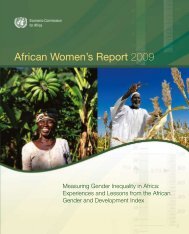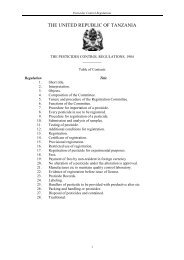Community-driven development decision tools for rural - IFAD
Community-driven development decision tools for rural - IFAD
Community-driven development decision tools for rural - IFAD
- No tags were found...
Create successful ePaper yourself
Turn your PDF publications into a flip-book with our unique Google optimized e-Paper software.
Partnership issues in CDD projectsVIIIDefinition of partnershipA guiding principle in selecting partners <strong>for</strong> <strong>development</strong> is to identify field agents who treatpeople as partners, not as “beneficiaries”. The principle of partnership is described in Box 26.Decisions regarding partner selection are critical <strong>for</strong> the success of a CDD project. Forinternational <strong>development</strong> agencies, certain partners are mandatory in all countries, while otherscan be selected during project <strong>for</strong>mulation and appraisal, depending on the nature and contentof the project, and on the options offered by the country’s institutional and policy setting.<strong>IFAD</strong>’s CDD projects establish partnerships with the central government, as mandated, andwith other actors in the public and private sector including• decentralized administration in the project area (usually the district governments);• local CBOs and their network organizations;• NGOs and other private service providers;• CSOs of public utility, if recognized by the government;• the Central Bank and financial institutions specialized orinterested in developing the <strong>rural</strong> financial market (<strong>for</strong>Box 26projects that include microfinance).Definition of partnershipTwo approaches <strong>for</strong> CDD projectsTwo different approaches in CDD policy were pursued by<strong>development</strong> cooperation agencies from the mid-1990s until about2006, though the differences that separate them are not verydistinct. One approach focuses on decentralizing publicadministration and the other highlights the role of civil society andpromoting strong CBOs. A simplified logical framework of the firstapproach is shown in Figure 2. In this approach, institution- andFigure 2CDD focusing on local government administrationsIn a partnership, two or morestakeholders operate jointly toachieve a common objective,sharing responsibilities, risks,costs and benefits of thecommon action, inaccordance with a predeterminedpattern, agreedupon by all stakeholders.InputsOutputOutcomeInstitutional support• Rules and procedures thatenhance the efficiency of localgovernment to deal with people• More effective policy dialogue• Increased fiscal decentralizationEnabling environment <strong>for</strong> delivery ofpublic goods and servicesCapacity-buildingCommunication know-howTechnical know-howPlanning and administrationskillsImproved organization culture oflocal government Willingness torespond to community demandImproved service capacity ofthe local governmentInvestment resourcetransferFinancial resourcesTechnical assistanceLocal governmentsprovide better servicesto individuals and CBOsIMPACTImproved livelihood throughsustainable <strong>development</strong> activitiesof individuals and CBOs53
















